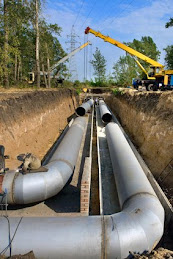 Here is a short timeline of the history of sewers from sewerhistory.org:
Here is a short timeline of the history of sewers from sewerhistory.org:3200 BCE Scotland
The Orkney Islands are the location of excavations that show early drainage systems.
First lavatory-like plumbing systems were fitted into recesses in the walls of homes -- with drained outlets.
Certain liquid wastes drained to area(s) either under or outside of buildings/homes.
4000 - 2500 BCE Eshnunna/Babylonia - Mesopotamian Empire (Iraq)
Had stormwater drain systems in the streets; drains were constructed of sun-baked bricks or cut stone. Some homes were connected. [The need for proper disposal of human wastes was not fully understood -- but there was a recognition of some of the benefits (less odor, etc.) of taking these wastes away from homes.]
In Babylon, in some of the larger homes, people squatted over an opening in the floor of a small interior room. The wastes fell through the opening into a perforated cesspool located under the house. Those cesspools were often made of baked perforated clay rings -- ranging in size from 18" to 36" in diameter -- stacked atop each other. Smaller homes often had smaller cesspools (18" diameter); larger homes ... more people ... had larger diameter cesspools. The annular space (1') outside of the cesspools' walls were often filled with pieces of broken pottery to better the percolation rates.
Origin of the earliest known pipe: Babylonia was documented by many as one of the first places to mold clay into pipe (via potter's wheel). Tees and angle joints were produced and then baked to make drainage pipe ... all as early as 4000 BCE.
Zonzini is your #1 source for pipeline and sewer repair in New York and Westchester County! They have a solid background and experience to ensure quality repair! Choose Zonzini for all your sewer and pipeline repair needs!
4000 - 2500 BCE Eshnunna/Babylonia - Mesopotamian Empire (Iraq)
Had stormwater drain systems in the streets; drains were constructed of sun-baked bricks or cut stone. Some homes were connected. [The need for proper disposal of human wastes was not fully understood -- but there was a recognition of some of the benefits (less odor, etc.) of taking these wastes away from homes.]
In Babylon, in some of the larger homes, people squatted over an opening in the floor of a small interior room. The wastes fell through the opening into a perforated cesspool located under the house. Those cesspools were often made of baked perforated clay rings -- ranging in size from 18" to 36" in diameter -- stacked atop each other. Smaller homes often had smaller cesspools (18" diameter); larger homes ... more people ... had larger diameter cesspools. The annular space (1') outside of the cesspools' walls were often filled with pieces of broken pottery to better the percolation rates.
Origin of the earliest known pipe: Babylonia was documented by many as one of the first places to mold clay into pipe (via potter's wheel). Tees and angle joints were produced and then baked to make drainage pipe ... all as early as 4000 BCE.
Zonzini is your #1 source for pipeline and sewer repair in New York and Westchester County! They have a solid background and experience to ensure quality repair! Choose Zonzini for all your sewer and pipeline repair needs!
